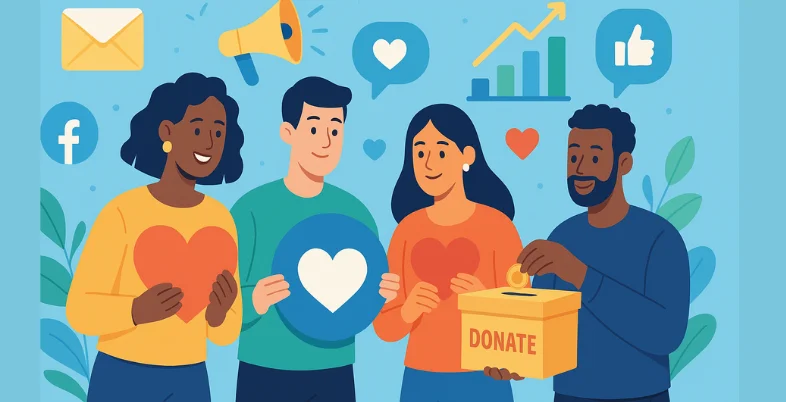Let me guess, you’re passionate about your cause, but your message isn’t reaching as far as you’d like. Sounds familiar? The truth is, that marketing for non-profit organizations is a must-have to stay on top in today’s landscape.
A targeted approach lets nonprofits expand their audience and raise more funds. Marketing Techniques For Non-Profit Organizations play a crucial role in this, as smart marketing amplifies their message and brings needed support. Let’s explore ways you can unlock your non-profit’s potential.
What You Should Know
Before we start, you must realize that marketing isn’t exclusive to big corporations. The truth is, that non-profit marketing requires creativity rather than deep pockets.
You have to engage donors, volunteers, and communities in ways that feel personal and authentic. And with a limited number of resources, your focus should fall on efficiency. Inbound marketing can become your go-to strategy since it attracts potential supporters whose interests align with your mission. With its help you can establish brand visibility, build organic audiences, and strengthen community engagement.
Email, Google Ads, peer-to-peer fundraising, and mobile-friendly efforts should all be in your toolkit. These tactics spread the word about your mission while keeping expenses low at the same time.
Understanding Nonprofit Marketing

Definition and Importance of Nonprofit Marketing
Nonprofit marketing is the strategic use of marketing techniques to promote a nonprofit organization’s mission, values, and goals. While for-profit marketing centers on selling goods or services, nonprofit marketing aims to raise awareness, attract supporters, and drive engagement for a cause. Your goal is to tell a story in ways that resonate with audiences and spark action.
Effective nonprofit marketing taps into various channels, including:
- Social media
- Email marketing
- Events
- Content marketing
Each one of them can reach and engage target audiences, so do not avoid those. Through compelling messages across the right platforms, nonprofits amplify their voice, connect with potential donors and volunteers, and expand their impact.
Nonprofit Marketing Challenges
Keep in mind the challenges of marketing for nonprofit organizations. For instance, nonprofits frequently have to be creative and effective in their marketing campaigns due to their limited resources. There is also a lot of competition for attention here, since many organizations are fighting for the same pool of volunteers and donations.
Another major challenge is measuring success: unlike for-profit businesses that can track sales and revenue, nonprofits must find ways to quantify the impact of their marketing campaigns in terms of awareness, engagement, and support. Plus, balancing multiple marketing channels and ensuring that all efforts align with the nonprofit’s mission and values can be rather daunting.
Despite the challenges, a well-planned nonprofit marketing strategy can help organizations overcome obstacles and achieve their goals. Everything is possible as long as nonprofits concentrate on specific goals and utilize the advantages of diverse marketing channels.
Creating a Nonprofit Marketing Strategy
Define Your Marketing Goals
The foundation of effective nonprofit marketing strategy is setting clear, specific marketing goals. Your objectives can follow SMART criteria: Specific, Measurable, Achievable, Relevant, and Time-bound.
Consider a goal to increase website traffic 20% next quarter – it’s specific and measurable, creating a clear target. Another goal: raise $10,000 in donations within six months, staying achievable and relevant for fundraising. Or boost social media engagement 50% over the next year, expanding reach and building a stronger online community.
SMART goals give teams direction and success metrics. This focus drives resource allocation and data-driven decisions to enhance nonprofit marketing strategy.
Nail Your Nonprofit Marketing Strategy
Email marketing offers non-profits a powerful connection tool. What could be better? It’s simple, affordable, and personal—even if you’re reaching many people. Newsletters can keep your community updated about projects, events, and fundraising efforts.
You can incorporate visually appealing and well-designed marketing materials, such as flyers and graphics, into your email campaigns. Subsequently, it will boost engagement and promote your nonprofit’s mission.
Here, consistency is your key. So, maintain steady communication without overwhelming your audience. Think of emails as ongoing conversations with supporters. You’ll get extra points if you don’t forget to ask donors how they’d like to get involved and contribute further.
One of the greatest benefits of email marketing is that you can share updates and stories that spark continued interest. And with each message, your audience will grow more invested in your cause.
If you’d like to learn other ways to engage your supporters through emails, consider this guide to non-profit newsletters. Inside, you’ll find great real-world examples and expert tips.
Maximize the Impact of Google Ad Grants
Marketing strategies like Google Ad Grants are an invaluable resource as well. Google provides free advertising to qualifying organizations up to $10,000 monthly.
Your organization can come up at the top of search results when someone looks for “volunteer opportunities” or “how to donate to education initiatives”, which will draw attention to your mission from a new audience. You have the golden opportunity to create ad copy that inspires action and emotion to convert clicks into real-world impact.
Leverage User-Generated Content for Social Media Marketing

The best marketers are actually the ones who support you. For non-profits, user-generated content, or UGC, is simply invaluable. The fact is, recommendations from others are more relied on than those from organizations.
Your supporters—donors, volunteers, or recipients—can share their stories and help your message reach a wider audience than traditional marketing ever could.
To do so, encourage the sharing of images, videos, and testimonies on social media by your community. Consistent messaging across social media posts is crucial. Leverage these posts to highlight user-generated content and utilize various social media platforms effectively to enhance outreach and connection with supporters. Then, the next step would be to ask that they share their personal connection to your cause and tag your nonprofit.
As a result, you’ll get authentic content that builds trust without straining your budget. Collective effort always yields impressive results!
Peer-to-Peer Fundraising
P2P fundraising can transform your supporters into fundraising champions. This method empowers your donors and volunteers to become your marketing team.
Peer-to-peer fundraising heavily relies on nonprofit marketing campaigns that use A/B testing to maximize engagement and boost donation volume. Just by comparing them, organizations can determine which marketing messages resonate best with donors.
Instead of just asking for donations directly, they reach out to their own networks. And since people trust those they know, these personal requests are more likely to bring in contributions.
Social media platforms make P2P campaigns even more accessible. Consider gamifying the experience with leaderboards. This will encourage top fundraisers to compete to make the biggest impact.
Be Mobile-Friendly with Marketing Strategies
Let’s face it: these days, we can’t leave the house without our phones. Thus, you’re losing out on a great opportunity if your website and donation platforms aren’t mobile-friendly.
Nonprofit video marketing is crucial in a mobile-friendly strategy as it effectively engages audiences and promotes nonprofit missions through platforms like TikTok and YouTube. Additionally, leveraging Venngage’s accessible features ensures that your videos and marketing materials are accessible to a wider audience, including those with disabilities, enhancing overall engagement.
Make sure that everything you offer is compatible with mobile devices. Literally, everything about it, from donation pages to event registration, should work flawlessly on any screen. Don’t forget to add a “text-to-donate” option for instant contributions.
Benefits of Marketing for Nonprofit Organizations
The fact remains: marketing for non-profit organizations should be your top priority. It increases awareness and opens doors for volunteer recruitment and fundraising. And the best part? With the right strategy, you can turn supporters into passionate advocates.
A well-structured nonprofit marketing plan delivers these benefits. It maps out a clear path, empowering nonprofits to set SMART goals, connect with target audiences, and tackle challenges unique to their initiatives.
Fundraising and Building Support
Marketing for non-profit organizations fuels fundraising efforts. Regular communication with donors through email, social media, and ads will keep them engaged.
A nonprofit marketing campaign plays a crucial role in fundraising by strategically targeting specific objectives tailored to your audience, enhancing outreach, and securing conversions such as donations or increased engagement.
They’ll remember why they supported your cause and, therefore, will feel inspired to continue. You have the power to convert one-time donors into recurring contributors, providing your non-profit with steady support.
A solid marketing strategy can also mobilize support during urgent fundraising pushes. Whether it’s an emergency appeal or a year-end campaign, the right plan makes these moments count. And when the donations increase, your non-profit will have more resources to make a real difference.
Increasing Volunteer Support

Volunteers are the lifeblood of many non-profit organizations. They want to help, but you must explain how. Good marketing will keep volunteers informed about new opportunities and events.
Selecting the right nonprofit marketing channels is crucial to effectively reach potential volunteers and engage them in your cause.
Telling stories about previous volunteer experiences will encourage others to get involved. And keeping them interested guarantees the growth and stability of your volunteer base.
Conclusion
Marketing for non-profit organizations, including social media marketing, can become your key to success. A well-thought-out plan will allow you to fundraise and reach a larger audience. Additionally, it will maintain the engagement and drive of your community to support your cause.
So, take a seat with your marketing team and go over these strategies, maybe you’ll find your go-to! Each one of them can help you with the spread of your message and increase the impact of your campaign.

